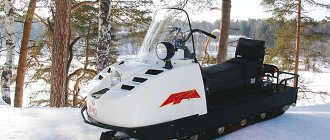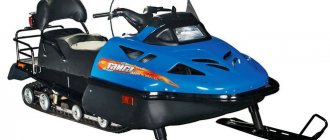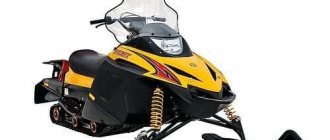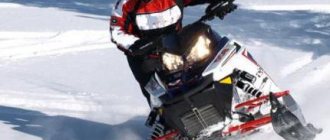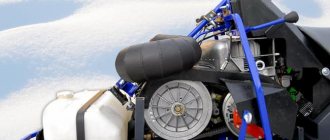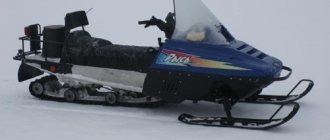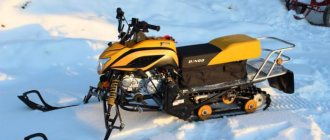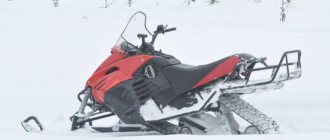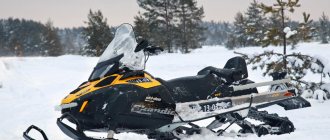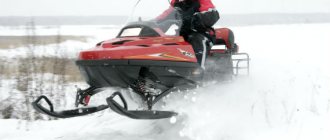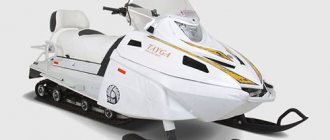The history of the storm is interesting in itself. Despite the fact that the first version of the Buran was developed back in the USSR, and the production of the Buran snowmobile began in 1971, this equipment is still in great demand, and not only among northerners.
This is initially a civilian model. This is exactly how it is still produced and successfully sold. Moreover, despite modifications with imported spare parts, the Buran’s design has not changed that much.
Description of the snowmobile "Buran" A/AE
These snow machines have been helping outdoor enthusiasts move through snowy areas for many years. "Buran" is recognized as one of the best domestic snowmobiles. The design basis of the technology has not been subject to global changes for about 45 years. But modern Burans are modernized and equipped with modern options and technologies. The main advantages of this model are considered to be high reliability and ease of maintenance and operation.
Thanks to the durable frame of the Buran snowmobile, tracks and one ski track, an active recreation enthusiast can reach hard-to-reach winter beauty. Simple controls allow even a beginner to drive a snow machine. The control system makes it easy to maneuver in dense forests.
What does the “A/AE” marking mean? – the first letter of the alphabet indicates a model with a short platform. The letter "E" indicates the electric starter function. It is generally accepted that the Buran A model is a classic snowmobile. Due to numerous requests from fans of the snow machine, the modern “Buran” remained in its original appearance.
In turn, “Buran AE” has now been improved. The changes affected the appearance of the hood and its fastening. After folding the trunk, access to the main components of the snowmobile opens. A comfortable and soft seat makes travel as cozy as possible. Having familiarized ourselves with the basic information, let’s move on to the review of the improved model “Buran A/E”.
What's being released today
At the moment, there is a certain set of model range of Burans, differing from each other in appearance and design:
- Snowmobile Buran leader;
- A;
- AE;
- snowmobile Buran Ade (AD);
- 4T and 4TD.
Each of these versions includes certain improvements that improve handling and ease of use of the snowmobile. For example, the Buran Ade snowmobile is equipped with an electric starter, and it also has an extended platform. Features of the classic model
First, let's look at the main technical characteristics:
- Buran engine. By default, an engine with 2 strokes and 2 cylinders is installed. It produces about 35 liters. pp., allows the snowmobile to reach speeds of up to 60 km/h. There are improved two-cylinder engines with 4 strokes. Fuel consumption up to 25 liters per 100 km. At the same time, Burans have RMZ 640 and a carburetor fuel system (carburetor 1). On some versions, injection systems are installed. It is also worth noting the electric starting system of the air-cooled engine. Most options also have an emergency start;
- The transmission in Burans is a variator type gearbox. Provision is made for the use of forward movement, as well as reverse and neutral gear;
- Mechanical disc brakes;
- Ignition is contactless. In addition to manual starting, it is possible to start using an electrical circuit;
- The front suspension is equipped with an elliptic spring, and the rear with a spring balancer (internal). The rear suspension is completely independent. Buran 640 does not have additional shock absorbers.
"Buran A/E" - detailed review
The snowmobile is equipped with a dynamic engine with a power of 34 hp. The working volume of 635 cc is enough to move through the snowdrifts as quickly as possible. All components and assemblies of this model are made to last, as evidenced by numerous positive reviews from Buran owners. That is, we can safely say that riding a domestic snowmobile fully meets safety requirements. Driving the snow machine is very easy. The steering wheel quickly responds to the driver's movements, which are transmitted to the front track. It is worth noting the high maneuverability of the unit. Movement in a dense forest area does not present any difficulties for Buran. To make it easier for the driver to select the required driving mode, the developers install a two-speed gearbox on the latest models.
Design and operation of Buran components
Those who want to purchase this car often have questions about the design of the Russian Buran snowmobile. It uses the following components:
- power unit device;
- transmission;
- mechanisms and controls;
- frame;
- electronic equipment.
Before starting work, it is recommended to read the operating manual, study in detail the design of the Buran snowmobile chassis and the principle of operation of the components and each system of the machine.
Engine device
The snowmobile is equipped with a two-stroke, two-cylinder carburetor power unit of forced air cooling. The device has a loop crank-chamber purge. Check out the components in the drawing (Fig. 1).
Engine elements table
| Engine components | Description |
| Crankshaft | A crankshaft with 3 supports is mounted on the power unit. A magdino rotor is installed on the right extreme part of the crankshaft, and a centrifugal variator regulator is installed on the left. |
| connecting rod | In each hole of the heads (upper and lower) of the connecting rod 12, needle bearings of different sizes are mounted: 16 and 9. The radial clearance ranges from 0.012 to 0.024 mm. The clearance can be ensured by sorting by size into size groups of bearing rollers, as well as piston and crank pins, which correspond to the holes of the connecting rods. Hole markings are made on the rod under all heads. |
| Piston ring | There are 2 rings 17 mounted on the pistons. The lock includes a thermal gap. After installing the rings into the engine cylinder (CL), the gap should be within 0.25 mm (not less). To obtain the specified gaps, you can file the ends of the lock. The gap between the ends of the ring and the grooves during compression should be up to 0.115 mm. |
| Piston | The engine has pistons: left 19 and right 22. The element is installed in the central line with a gap that between the piston skirt and the central line is 0.16 mm. If the engine overheats, the piston will jam in the cylinder. There are 3 groups of pistons: M, S, B (smallest, medium and largest). The group designation with dimensions is marked on the inner belt of the piston skirt. |
| Piston pin | During the assembly process, piston pins are sorted by outer diameter into 2 groups. The group is marked with light or dark colors of paint at the end of the finger. During the assembly process, the pin with the piston is selected from the 1st group. |
| Cylinder head | Two TsL heads of sizes 20 and 23 are made of Al alloy. To prevent changes in the structure of the head and cylinder, the stud nuts should be tightened crosswise in 2 steps: first preliminary, and then finally tightened to 2.5 kgf/m. The manifold mounting nuts must be tightened first. They need to be tightened when the power unit is not warmed up. |
| Cylinder | 13 and 21 TsL are not interchangeable. To ensure selective assembly of the liner-piston interface, cylinders are produced in 3 size groups. The size groups are marked with the letters: M, C, B and are stamped using the impact method on the belt of the lower flange of the cylinder. When changing the CL, a new one of the corresponding group must be installed. The CL is mounted on the engine crankcase, and the head is installed on the top one. There is a gasket 18 between the head and the cylinder. There is also a gasket 11 located in the center between the flange and the supporting plane. |
| Carter | This part consists of 2 halves. They are connected by spiers screwed into its upper part; the fastening nuts are tightened with a torque of 3 kgf/m. For tightness, copper gaskets are mounted under the heads of bolts 73 screwed into these products. |
| Engine cooling | When the motor is turned on, the temperature should be up to 200 °C. To maintain the motor temperature within normal limits, the use of an air cooling system is required, including an axial blower fan and additional blower casings. The basis of the fan is an impeller 24, driven by a V-belt 30 from a drive pulley 36 mounted on the flywheel rotor. At the end of the impeller shaft there is a driven pulley, which includes two half-pulley disks 29. The fastening nut is tightened with a torque of 5 kgf⋅m. There is an air intake 31 in the inlet part of the fan. |
The figure shows the parts of the power unit device, which were described above, by numbers.
Engine
When turning on the power unit, you should sometimes check the quality of the fan belt tension. If it is weak, then the effect of belt slipping at high speeds and its delamination due to heating may occur. If the tension is strong, the impeller bearings break. If lubricant gets on the belt, it may be destroyed. Avoid this and replace the part on time.
The Buran engine is equipped with a mechanical device, except for Buran 4T, 4TD; other models have an electric starter. Manually installed on the case fan with 4 fans. The housing part contains a starter pulley with elements of a ratcheting mechanism. The return spring is made spiral, its ends are curved. The outer end of the spring is secured to the cast indentation of the pulley, the inner end - to the protrusion.
If the manual starter fails, there is the possibility of an emergency start of the engine. Carry out it according to the instructions in the operating manual, subsection 3.3.
Purposes of other components intended for the operation of the motor and its control:
- Supply system.
- Fuel tank.
- Settling filter.
- Hand pump.
- Air purifier.
- Carburetor.
- Fuel pump.
- Exhaust system.
- Power unit suspension. The elastic supports of this part of the engine consist of rubberized shock absorbers that are mounted on nuts. The latter are installed on bolts that are inserted into the frame holes.
The motor is mounted to the base using 4 bolts. To adjust the distance between the variator pulleys, rings are installed.
Suspension of the Buran power unit
On the Buran frame, the engine with a sub-motor base is fixed at 4 points. The elastic suspension reduces the transmission of vibration from the operating motor to the frame, and shocks that occur while driving.
Transmission (drive)
The transmission of the Buran snowmobile chassis consists of two elements: a V-belt type variator and a chain-type reverse box. The variator (Fig. 2) is a V-belt transmission with an automatic change in the functional properties of the pulleys (main and driven) through a centrifugal regulator when the speed of the motor and cam clutch changes when the resistance to movement of the device changes.
The main parts of the variator: a driving friction wheel with a rim (pulley) with a centrifugal regulator, which is installed on the motor axis, and a driven one with a cam clutch on the head shaft of the reverse box, as well as a belt.
Driven friction wheel with rim includes:
- fixed disk (ND) 21;
- mobile (PD) 1;
- return spring type 22;
- half coupling (PF) 3.
The last part of the driven pulley is held on the axis from turning by key 2. During the operation of the variator, the 5 PF liners move along the top of the PD screw. The spring is located between two parts - the coupling half and the PD, and it is pre-loaded and twisted by 120 degrees. The split ring (RK) 28, which is installed on the axis by a spring ring 29, is a restrictive part, namely, it stops the movement of the PD to the LP and is at the same time a stop for the stationary one, mounted on the axis by a spring ring (SC) 29, and a stop for the LP mounted on shaft using a key 23, a washer (W) 26, a locking washer 25, a bolt 24. Between parts 28 and 21 there are adjusting rings 27 to obtain the desired size of the driven pulley. There are 3 threaded holes for dismantling the LP.
Variable speed drive
Reverse box
The reverse gearbox (RR) of a snowmobile is designed to transmit torque from the head shaft to the axles of the main track sprockets, performing reverse movement and disconnecting the motor from the chassis.
The box (Fig. 3a) includes shafts: a drive shaft to start the reverse movement, a shift mechanism and a chain drive, which includes forward and reverse sprockets, as well as a driven shaft, a chain tensioning mechanism and a drive chain (98 links in total).
The control of the control gear is performed manually, that is, by a drive, which consists of a shift handle and a rod connecting the handle together with the lever of the mechanism.
Chassis
Consists of a track and a ski. Let's look at their structure in more detail:
- The tracked mover contains tracks, guide and drive axles with stars and roller balancers. The tracks are installed so that the right angle of the lugs is directed forward, because they crush the snow under themselves without gripping it.
- The steel brackets mounted between the windows are designed to precisely engage the head teeth and guide sprockets. Driving with dropped staples leads to rapid wear of the teeth and tracks due to damage and rupture of the bridges between the windows.
Drive axle of tracks
The drive axle (Fig. 4) is located in front of the machine frame and includes a steel hollow shaft 5 with attached hubs 4, 2 and sprockets 3 mounted between them. Each of them can be attached to the hubs with bolts and nuts. At the ends of the shaft there are bearings 10 and cuffs 9. There is a retaining ring 13 between the shaft support and the cuff.
Guide shaft
The guide shaft (Fig. 5) contains a complete shaft 23 with hubs 22, 17 attached to it, which are placed between parts of the sprockets 19, bearings and cuffs: the retaining ring 12 and washer 11 are located between the cuff and the bearing.
Lubrication of the axle supports is carried out during component assembly and during maintenance through a hole in the balancer cheek, which is closed with a plug 13. The guide shaft is placed in an important part of the frame on balancers 24.
Other chassis components:
- Ski and its suspension. The steering ski is made of steel, it is stamped. A runner 16 is mounted at the bottom of the ski, which protects it from wear.
- Steering. It consists of other components: steering column, swing arm, kingpin, shock absorber.
The steering column is installed through bushings, which act as sliding bearings, to the brackets of the rack and box with special covers 13. The steering wheel is connected by a cover and bolts to the body of the column.
Frame
It is the basis for the installation of each mechanism and unit. Main components of the case:
- frame;
- casing;
- seat;
- hood;
- instrument panel
The frame is load-bearing, it is rigid and welded. The frame elements are made from sheet steel. The rigidity of the structure is ensured by a frame made of corners and pipes. The frame is made of pipe, the hood is made of fiberglass and covers the compartment consisting of the engine and transmission. On the side where the seat is located, the engine is covered by a casing and an instrument panel. Instruments and an element of the apparatus controls are installed on it. The folding seat, designed for 2 seats, is located on the frame with articulated hinges.
There is a loading area in the rear half of the frame. At the consumer's request, Buran snowmobiles are additionally equipped with a kit for installing skis.
Control mechanisms and instruments
The location of control devices is shown in Fig. 6.
Controls
The brake lever is located on the left of the steering wheel. When you press the lever, the brake mechanism is activated, and when you release the lever, it automatically returns to its original state. Slowing down the snowmobile will depend on the quality of the snow cover.
Rapid and frequent braking of a vehicle moving at high speed can cause overheating of the brake mechanism, which leads to a significant decrease in braking efficiency.
Handbrake stop light element switch. When the brake lever is activated, the rod closes the contacts, and the brake light lamp, which is installed in the rear lamp, turns on. After releasing the lever, the switch rod completely opens the contacts, and the lamp goes out.
Other controls and mechanisms:
- light switch;
- gas lever heater element switch (VNRG);
- ignition switch (IZ);
- oil indicator (IM);
- emergency switch (AB);
- speedometer;
- gas lever;
- parking brake device limiter;
- steering wheel;
- egnition lock;
- starter and reverse gear shift handles;
- levers of fuel correctors of carburetor devices;
- knob for resetting the daily counter;
- pump handle;
- spotlight switch (optional):
- socket (optional):
- carburetor element control drive.
The brake must be fixed with the reverse gear engaged.
Electrical equipment
The snowmobile uses a 12 V combined electronic equipment (EC) system; one wire for the rear light, two wires for the other EO.
An electronic ignition system operating in a contactless manner is created by different manufacturers:
- FSUE "UAPO", Ufa;
- Flames Company LLC, Moscow.
The ignition system should be installed on vehicles only in kits; if a separate element of the ignition system (except for the flywheel device) is used, engine damage may occur.
Other elements of electrical equipment:
- stator;
- Magdino foundation;
- rotor;
- ignition system coil;
- switch;
- candle type tip;
- candle;
- electric starter;
- starter relay;
- rear lamp;
- fuse;
- headlight;
- stop light switch;
- voltage regulator;
- battery;
- electronic wiring;
- electronic plug connectors.
Some modifications of Buran are equipped with a system with an electrical unit, which, when receiving information from sensors located on the engine, controls the injectors and coils of the ignition system.
Design, appearance
Looking at the front of the snowmobile, you can see the windshield, which protects the driver from headwinds and snow. As already mentioned, there is one ski track in the front part. Thanks to this track, turns and maneuvering in general are carried out. Also striking from the front is the headlight, which provides adequate illumination of the road at night. On the sides of the headlight there are longitudinal holes in the hood, through which the engine receives cooling.
In the rear, immediately above the tracks, there are mudguards. A towing device can be seen between them. Thanks to this design solution, it is possible to tow a trailer weighing up to 250 kg. As a rule, hunters and fishermen place the necessary equipment on such cargo platforms.
"Stealth Frost"
The unique snowmobile has a modern design and decent technical characteristics. The equipment includes only one ski, with a focus on the northern regions of the country. This technique is available in two modifications, the parameters of which are identical to each other. The difference lies in the extended base and weight (320 and 295 kg).
The car is driven by a two-stroke engine with a pair of cylinders with their own carburetors. The ignition system is developed on the basis of special programming; the unit is protected from overheating by forced atmospheric cooling. Reinforced steering column - adjustable configuration, handles and throttle trigger are heated. The hydraulic brake is responsible for stopping. The driver's seat is soft, comfortable, and does not slip. The modern hood has special holes that serve to redirect the air flow to the engine.
About practicality
Sometimes there is a need to transfer things and equipment to the maximum. It is in such cases that a spacious trunk is simply irreplaceable. In this case, there is a spacious luggage compartment, which is located under the seat.
Fast and, one might say, trouble-free starting is carried out due to an electric starter. Let us remind you that the presence of an electric starter on the “Buran” snowmobile is indicated by the “AE” marking.
In general, the domestic snowmobile under consideration is worthy of attention. This is a reliable and practical model at an affordable price. A snowmobile will cost approximately 230 thousand rubles.
Possible breakdowns and ways to eliminate them
While driving, malfunctions may occur that are caused by wear, violation of adjustments and maintenance rules. If they are quickly eliminated, further dangerous consequences for the device will be eliminated and normal operation will be guaranteed.
- Engine. If it does not start, then one of the reasons may be a clogged vent hole in the fuel tank cap. Clean this hole.
- Transmission. If the reverse box does not switch, the cause may be a malfunction of the switching mechanism - adjust it.
- Chassis. A common symptom of a malfunction may be play in the support roller on the shaft and its runout in the side surface. Possible causes: bearing wear or change in axle shape. To solve problems, replace the bearing, inspect the axle, and replace it if necessary.
- Snowmobile control mechanism. Sign of breakdown: tight rotation of the steering wheel. The cause of the problem may be a stuck steering axle, a ski pin, or a faulty steering drive. To solve the first problem, lubricate the bearings, for the second, the working surfaces.
- Electrical equipment. If there are interruptions in the ignition system, a weak spark or no spark, a possible cause of the malfunction may be a non-working spark plug (it becomes oily or dirty). Remedy: clean off carbon deposits, rinse in gasoline and wipe well. Determine and eliminate the causes of carbon deposits (incorrect composition of the combustible mixture - improper carburetor adjustment). There may also be problems with the wire - replace it if it breaks.
If the starter works on a snowmobile, but the engine axis does not rotate, then the following causes of malfunction may be: nicks on the gear teeth, lack of engagement, slipping of the freewheel. Eliminate nicks by refilling damaged teeth or replacing worn elements. If the clutch slips, it needs to be repaired in a workshop.
"Stealth Ermak 800"
This modification replaced the morally and technically outdated Buran. "Ermak" has the same weight, but much better dynamics and equipment. The peculiarity of placing the gas tank (between the driver’s legs) eliminates the possibility of it being damaged by branches. The equipment is protected from stumps and logs from below by an aluminum shield.
The car is driven by a four-stroke engine with a power of 67 “horses”. Average fuel consumption is about 20 l/100 km. The tank holds 50 liters of fuel. The gas grip and steering wheel are heated. The special configuration of the lenses on the light elements guarantees good illumination.
Characteristics and dimensions of the “Stealth Ermak 800” snowmobile:
- suspension – telescopes at the front, independent lever block at the rear;
- transmission – automatic transmission with CVT;
- propulsion unit – one caterpillar, 38 cm wide;
- brakes – hydraulic disc system;
- length/width/height – 3.1/1.02/1.33 m;
- lug height - 17.5 mm;
- structural weight - 290 kg.
